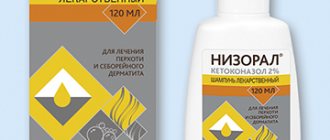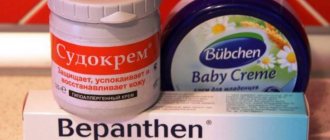Hydrocele in a child (in other words, hydrocele) is a pathological process that involves the appearance of fluid in it. Late treatment or lack thereof leads to significant swelling of the groin.
Often the disease has a one-sided manifestation and is therefore difficult to detect.
To prevent the pathology from developing and spreading to other organs, it is necessary to ensure that the sick baby is monitored by the attending physician, as well as preventive examinations.
What is the disease?
A hydrocele (as dropsy is called in medicine) is an accumulation of fluid in the lining of the testicle. In most cases, this pathology is one-sided and is accompanied by an inguinal hernia. In adult men and older children, it occurs in only 1% of all cases.
The term hydrocele is made up of the Greek words “water” and “tumor,” which perfectly characterizes the clinical picture of the disease. Most often, at an early stage, the pathological process goes unnoticed, when a lot of fluid accumulates in the scrotum area, the disease begins to bother the child.
Physiological hydrocele in newborns does not require treatment. With it, the boy is monitored by a urologist; if after some time the amount of fluid in the scrotum area increases, therapy begins.
Statistics on the incidence of hydrocele
The disease is common and occurs in about 9% of newborns in the first months of life.
In newborn boys, the disease is diagnosed in the maternity hospital during the initial examination, and in older children, the manifestation occurs later.
In 80% of cases, the disease is isolated and can resolve itself.
In 20% of situations after one year of age, surgery for hydrocele is performed. If a boy is diagnosed with an illness when he reaches the age of 1 year, surgical intervention is indicated in 95% of situations.
Causes of testicular hydrocele
Until the 28th week of intrauterine development, the testicles are located inside the boy’s abdominal cavity. Then they gradually begin to move into the scrotum. Sometimes this happens only after the baby is born.
During movement, they can capture part of the abdominal tissue, which leads to a slight increase in the scrotum. There is no discomfort in this case. After obliteration of the abdominal tissue, the physiological hydrocele disappears.
Congenital
Hydrocele of the testicles in newborn boys is caused by various reasons. The movement of the vaginal remnant of the abdominal cavity into the scrotum is the main one. In this case, obliteration does not occur; peritoneal fluid moves through these tissues. The tissues of the vaginal remnant can independently produce it, which leads to a pathological hydrocele.
Hydrocele in boys often develops against the background of a pregnant mother contracting rubella. This infection leads to severe developmental disorders of the fetus, so doctors recommend abortion if it is detected.
There are several reasons for this anatomical deviation. The vaginal process does not heal due to:
- violations of gestation (threat of miscarriage, intrauterine infection with infections or viruses, diseases or bad habits of the mother);
- injuries received during childbirth;
- use of medications during pregnancy;
- prematurity;
- abnormal development – failure of the testicle to descend into the scrotum (cryptorchidism), displacement of the exit of the urethra to the shaft of the penis (hypostage);
- genetic predisposition;
- increased pressure inside the abdominal cavity.
Important! Some of these reasons can lead to the development of hydrocephalus. This disease is also associated with the accumulation of fluid; the cavity with it is located not in the scrotum, but next to the brain.
Congenital hydrocele rarely requires surgical intervention; most often, the symptoms of the disease cease to appear by 6-12 months. Additional procedures to reduce pressure inside the scrotum are undertaken in only 15% of cases.
The congenital tumor does not communicate with the abdominal cavity; only in 10-20% of cases the fluid migrates, which increases the risk of developing hydrocele of the inguinal canal.
Acquired
If high pressure in the abdominal cavity is not congenital, it can be caused by:
- ascites (fluid accumulation in the peritoneum);
- performing peritoneal dialysis;
- installation of ventriculoperitoneal shunts.
Hydrocele of the testicle in children aged 2 to 14 years is caused by:
- groin injuries;
- testicular torsion;
- inflammatory processes of this organ (epididymitis, orchitis);
- diseases of the lymphatic system, including those caused by helminths;
- tumor in the epididymis or testicles themselves;
- complications of infections (ARVI, influenza, mumps);
- pathologies that occur after surgical interventions accompanied by damage to the spermatic cord;
- severe insufficiency of the heart and blood vessels.
These diseases lead to the accumulation of blood in the scrotal area. The older the child, the more dangerous this pathology is for him. When it occurs during puberty, it leads to sexual dysfunction and infertility.
There is a myth that wearing diapers incorrectly in newborn boys can lead to the development of hydrops. Doctors deny this fact, since there is no connection between the use of absorbent panties and the accumulation of fluid. Therefore, you should not adjust the testicles when using them.
Treatment of testicular hydrocele in newborns
In children under 1.5 years of age, hydrocele disappears on its own. Additional intervention and assistance from a doctor is most often not required. The lumen successfully closes, the fluid disappears, and the swelling disappears. This is why treatment of hydrocele in young children is most often not carried out. Doctors must constantly monitor the child’s condition. When. If the scrotum reaches a significant size and becomes a cause of concern for the child, the issue of surgical treatment is decided.
If the hydrocele has not resolved on its own by the age of 2 years, surgical treatment is recommended, even if there is no noticeable discomfort. For inguinal hernia in combination with hydrocele, surgery is performed at an early age.
In children over 2 years of age, hydrocele is not only subject to observation, but is also subject to drug treatment within 3-5 months from the moment of detection. In acute cases, anti-inflammatory and antibacterial agents can be used. If an upward trend is detected, an operation is proposed.
Operations can be performed using several methods:
- Winkelmann method. The doctor cuts the anterior surface of the scrotum and testicular membranes to gain access. Using a syringe, the accumulated liquid is removed from the cavity. The shells are turned inside out and stitched using self-absorbable threads. In this case, the liquid does not remain between the membranes, but is absorbed by the tissues. In case of communicating dropsy, the lumen is additionally sutured.
- Operation according to Bergman. It is carried out for isolated dropsy, when the scrotum reaches a significant size. The walls of the bag have a significant thickness. The incision is made at a minimum distance from the groin, and the internal membranes are excised. In some cases, installation of drainage and a pressure bandage is required.
- Operation by Lord. The least traumatic method, which is often used for hydrops in newborns. Its only drawback is that the technique can only be used if the scrotum is not significantly increased in size.
The doctor will be able to select the optimal treatment method after assessing the condition of the skin and considering the appearance and type of dropsy. The operation is performed in a hospital setting. The duration of the intervention is 20-30 minutes.
In some cases, dropsy can be treated using the puncture method. This technique is low-traumatic, but is not widely used due to the high risk of infection.
Classification of the disease
According to the type of course, pathology is divided into groups.
- The cause of the acute course is past inflammation and respiratory diseases. The disease occurs as a complication of mumps, influenza and other infections. Treatment must begin immediately as soon as the main symptom appears - testicular enlargement.
- Chronic is a recurrent acute process. This type of disease develops if acute hydrocele has not been identified and treated.
The disease can be classified in several other ways. One of them divides pathology depending on fluid pressure:
- Tense is characterized by severe pain and a significant increase in the scrotal area.
- Non-tense is characterized by the fact that the fluid pressure in the scrotum changes.
Classification by fluid pressure is directly related to the position of the vaginal duct. If it is closed, then the disease is called isolated. It is treated only with surgical intervention, and does not cause complications in the form of an inguinal hernia.
With a communicating hydrocele, fluid circulates from the abdominal cavity to the scrotum and then back again. This type of disease often causes a complication in the form of an inguinal hernia, which can only be eliminated surgically.
Depending on the location, the disease is divided into unilateral and bilateral. The first option is most common, with fluid accumulating next to one of the testicles. With physiological dropsy, the scrotum enlarges completely.
How to detect hydrocele?
The main symptom of this disease is an enlargement of the child’s scrotum on one or both sides. Most often, the tumor affects only one testicle. Parents should immediately consult a doctor after detecting this sign of hydrocele. First, it is enough to visit a pediatrician, he will prescribe an ultrasound and a consultation with a urologist. Additional diagnostics make it possible to clarify the nature of the tumor and reveal its features.
With acute hydrocele, symptoms are observed:
- pain in the groin area;
- redness of the skin of the scrotum;
- nausea and vomiting;
- increased body temperature;
- general weakness, decreased motor activity;
- fever.
A small child cannot talk about his feelings, so it is necessary to focus on other signs of illness. Infants who cannot clearly explain their condition become lethargic, cry and are capricious for no reason, and pull their hands to the groin.
Most often, parents cannot find the reason for the change in the baby’s behavior; they can only notice an increase in the scrotum while changing the child’s clothes or when changing the diaper.
You should not try to cure a child in this condition on your own. Dropsy in boys can only be eliminated through surgery; other means are ineffective.
Manifestation and symptoms of the disease
Typically, symptoms of hydrocele disappear by two years and do not require additional treatment measures. If this does not happen, it will be necessary for a specialist to intervene in the matter, who can accurately diagnose and prescribe treatment.
The progression of symptoms occurs unnoticed, if you do not take into account the enlargement of the testicle. Liquid accumulates in it, which leads to such changes. To prevent the disease and its timely treatment, it is recommended to study the main signs.
- The scrotum begins to enlarge on one or both sides: it becomes noticeable only when the baby tenses his tummy.
- In the process of carrying out an independent palpation method, the mother may also detect a pear-shaped formation.
If such signs occur, you need to contact a specialist to conduct additional research and get tested.
It is also important to pay attention to secondary additional symptoms, which also play an important role.
- manifestation of pain in the groin area;
- the appearance of redness in the skin of the scrotum;
- sensations of nausea and a pronounced gag reflex;
- the occurrence of general tremors in the body;
- noticeable increase in temperature, malaise.
Often mothers who have discovered such signs in their baby try to independently treat the child. However, there is no need for independent measures, since only a doctor can give advice and recommendations for the treatment of hydrocele.
Diagnostics
The initial stage of diagnosis is collecting anamnesis and examination by a urologist or surgeon. The doctor interviews the parents in detail about their complaints, and then examines the scrotum area in a standing and lying position. The position of the body must be changed to draw a conclusion about the nature of the dropsy:
- with the relaxed type, the swelling decreases in the supine position;
- when isolated, a change in body position leads to an increase in the amount of fluid.
The boy is then asked to cough, as this action increases intra-abdominal pressure, which causes fluid to flow to the testicles. The doctor conducts the examination not only visually; two techniques are used for diagnosis:
- palpation for dropsy reveals a bubbly elastic tumor in the scrotum, resembling a pear, its upper end always facing the groin;
- examination with a flashlight (a method called transillumination or diaphanoscopy) - the tissues surrounding the testicle allow light to pass through, but it is retained by fluids and hernias.
Hardware diagnostic methods allow you to clarify the condition of the boy’s duct and correct the diagnosis:
- Doppler ultrasound of the groin vessels - allows you to determine concomitant pathologies and clarify the nature of the tumor;
- Ultrasound of the groin area - accurately examines dropsy, finds additional pathologies, allows it to be localized and classified.
With the help of ultrasound examination, it is possible to exclude other, more dangerous diseases - torsion of the testicle and its appendages, inflammatory processes. Also, using this type of examination, you can determine the condition of the testicle. The final method used to make a diagnosis is blood and urine tests. They are necessary for differential diagnosis and help determine the general condition of the body and the presence of complications.
Important! If there is a suspicion of filariasis or oncology, a puncture is performed.
Treatment
Doctors do not immediately resort to surgery. If an infant is sick, he is observed until he is 2 years old, only then a decision is made. If dropsy occurs at an older age, then you need to regularly visit a urologist for 2-3 months. If swelling increases during the observation period, conservative treatment is prescribed. It is symptomatic.
One of the conservative methods is puncture, in which a tissue sample is not taken, but excess fluid is removed. The procedure is carried out under sterile conditions in a hospital. The doctor’s task is not to cause orchitis, which occurs against the background of an infection brought inside the scrotum. In case of relapse, the manipulations are repeated.
The urologist may abandon wait-and-see tactics if there are frequent exacerbations of hydrocele. An operation may be prescribed for an infant if the dropsy is accompanied by a hernia of the inguinal ring or an infection. A secondary disease caused by an inflammatory process in the body begins to be treated only after treatment with antibacterial and non-steroidal drugs.
Surgery is necessary if urination is difficult.
Treatment methods
The only treatment for dropsy is surgery.
IMPORTANT : If a child develops a disease after a year, surgery is necessary.
You can wait up to 2 years for testicular hydrocele to go away in newborns. If a 2-year-old child has hydrocele, surgery is the only treatment option.
The procedure is carried out under general anesthesia so as not to traumatize the child’s psyche. He falls into a deep sleep, and the surgeon carries out all the necessary manipulations.
The child must be at least 1.5 years old. This is a safe operation for the boy’s health, which in most cases does not have a negative impact on the sexual sphere in the future.
Its duration is about 40 minutes. All manipulations are carried out under careful monitoring of the boy’s blood pressure and heartbeat.
After falling asleep, a catheter is installed and surgery is performed. The boy is left in the hospital for several days to monitor his well-being. After discharge, recommendations on wound care are given.
If a 2-year-old child has hydrocele, surgery is the only treatment option.
We recommend reading the following articles on the topic of hydrocele in children:
- causes of testicular hydrocele in newborns;
- methods of surgical intervention in children after 2 years of age with the disease;
- progress of the procedure to remove dropsy;
- treatment without surgery;
- consequences of the disease.
Surgical treatment
The need for surgical intervention is determined by the doctor, taking into account:
- child's age;
- causes of hydrocele;
- degree of severity;
- parental consent;
- the rate of progression of the disease.
There are several ways in which the intervention is carried out.
Operation name – Brief description:
- Ross - Used for a reported type of pathology. During the intervention, the inguinal ring is excised and bandaged.
- Bergman - Selected for an isolated form of the disease. The inner lining of the testicle is excised as close to the base as possible, and then the remains are sheathed. Sometimes the surgeon must install a drain and apply a pressure bandage.
- Winkelmann - A 5-centimeter incision is made on the scrotum, the testicle is removed into the wound, and the fluid is removed. At the end of the operation, an examination of the testicle and plastic is required.
With it, the remaining membranes are turned out and sutured. This technique is traumatic and is practically not used in modern medicine.
- Lorda - With it, the vaginal membrane is corrugated in place, so this method of treatment is gentle.
The method is selected based on the capabilities of the surgeon and the location of the tumor. Technically, all these types of operations are simple interventions, but they need to be carried out only under general anesthesia, which worsens the situation. The surgeon has better control over the course of the intervention under local anesthesia.
Surgery
The operation assumes the presence of an indication in the form of a significant change in the size of the hydrocele of the testicle, because this factor can contribute to the formation of a hernia and cause strangulation of the intestine.
The operation will remove the disease without leaving a trace; several types are currently being carried out.
Winkelmann operation
This operation is performed using general anesthesia. In this case, a small cut of 5 cm in the skin is made on the scrotum, on its swollen area, and the testicle is removed to the wound.
Then all the liquid is removed from the shell. When carrying out the technique, the entire testicular area is also subject to examination. To speed up recovery, apply an ice pack to the wound for several hours.
Bergman's operation
This operation has several repetitions with the previous technique, especially at first. The size of the incision made in the scrotum area is 6 cm.
After this, the membranes are cut layer by layer, and the testicle is brought out onto the wound, the doctor pumps out the resulting fluid. Sutures are placed on the cutout fragments, then the testicle is “inserted” back.
Operation Lord
This operation is accompanied by cutting the pouch and subsequent corrugation of its shell. This treatment of testicular hydrocele is one of the most effective and safest methods.
Preparation period and course of the operation
During the preparatory period, it is important for parents to monitor the child’s condition. There are several rules:
- At least a month must pass after a cold or infectious disease;
- Before hospitalization and intervention, blood and urine tests are required;
- 6 hours before the scheduled operation, the child should not be given food or any drink.
General anesthesia is used so that the child does not experience psycho-emotional shock from an unfamiliar environment, instruments and doctors in gowns and masks. To select medications, a consultation with an anesthesiologist is provided, who monitors the baby’s body’s reaction to the selected anesthesia. Additionally, an anesthetic is administered by injection into a vein, which makes the postoperative period less traumatic.
Caring for the child after the intervention and possible complications
The postoperative period can be divided into 2 parts: time spent in the clinic and home treatment. You can take water and food a few hours after the intervention. As the anesthesia wears off, the child may experience pain again. It can be treated with drugs:
- "Ibuprofen";
- "Paracetamol";
- "Nurofen";
- "Nise."
At home, you need to create conditions under which the baby’s physical activity will be reduced for a month. The groin area should always be covered with clothing so that the baby does not touch the sore spot with his hands. If this behavior is not prevented, the risk of bleeding and wound infection increases. During water hygiene procedures, you need to monitor the wound; it should not be wetted. You can treat the intervention site with the following medications:
- "Chlorgeskidine";
- "Kalimin";
- "Betadine."
Antiseptic treatment during the recovery period should be carried out after each diaper change or several times a day (for older children). Nowadays, surgeons everywhere use self-absorbable materials for suturing. If simple threads were used, they are removed after a week. Using standard threads increases the risk of complications - infection and bleeding.
After the intervention the following conditions may be observed:
- bleeding - if this occurs, you need to urgently contact a surgeon;
- relapse – occurs if the testicle after surgery has risen above its previous level;
- infertility – if blood vessels are damaged during intervention;
- impaired blood supply to the testicle and its atrophy;
- scrotal deformity;
- discomfort and pain in the groin;
- fixation of the testicle on scars.
Important! If you suspect the development of complications, you should contact a urologist.
It is easy to notice the development of infection. For the first 3 days, redness around the suture area is considered normal, but if after three days the skin tone remains intensely scarlet, then bacteria have begun to multiply in the wound. Swelling and increased pain may also occur; in advanced cases, suppuration occurs.
Sclerotherapy
For hydrocele in a child, sclerosing drugs are used for treatment without surgery. This method has a contraindication - it cannot be used if the type of illness is reported. This treatment method involves injecting an antiseptic (Betadine or alcohol) into the scrotum.
If the vaginal duct is not closed, the solution may enter the abdominal cavity. For isolated dropsy, this modern method can be used. It is one of the most modern and safe. In 98% it leads to complete cure. After administration of the drug, an aseptic inflammatory process occurs in the tissues of the scrotum. Subsequently, they are completely fused, removing the cavity for fluid accumulation.
Types of disease
Communicating dropsy
Communicating hydrocele in children is a common condition. In the absence of fusion of the membranes or their obliteration, we can talk about the preservation of the cavity of the vaginal process, which is open into the peritoneal cavity.
If only fluid is retained, there may be a communicable disease. Hydrocele may appear on the left or right testicle, as well as on both sides.
Often, the omentum or intestinal loop may be adjacent to the liquid medium; in this situation, an inguinal hernia is formed, requiring urgent surgery.
Isolated dropsy
Typically, hydrocele of this type occurs in premature babies; a common cause lies in insufficiently developed lymphatic vessels or in trauma received during childbirth.
The formation of non-communicating hydrocele of the testicle occurs when the fluid is not completely absorbed; at the same time, other membranes may be underdeveloped.
Usually the fluid returns to normal on its own, and the process does not require medical intervention.
Acquired dropsy
If there is an acquired disease, it occurs during injuries to the scrotum, due to inflammatory processes in the body and as part of the delayed consequences after hernia operations.
Such a disease should be treated by a medical professional.
Complications
Chronic hydrocele in a boy or untimely treatment leads to consequences. They may be:
- secondary type infection, development of inflammation;
- decreased testicular size with an enlarged scrotum;
- compression of the hernia;
- tissue necrosis;
- infertility.
Congenital hydrocele usually goes away on its own within a year and does not cause complications. Timely surgical intervention, performed in compliance with the technique, also allows you to get rid of the pathology. A competent approach to therapy will help maintain men's health.
Treatment with folk remedies
Traditional medicine can be used in children over 10 years of age. At the same time, you should not take risks and use therapy with leeches or medicinal compounds without the permission of a doctor. Most often, urologists do not object to the use of prescriptions.
- A decoction of chamomile inflorescences. Boil a liter of water and pour 3 tablespoons of dry chamomile into it. Leave the preparation on the fire for 2-3 minutes, strain the broth through cheesecloth and cool it. It is better to leave the inflorescences remaining in the gauze in the liquid for an hour and then remove them. The child should be given this medicine 5 times a day, 100 ml.
- Boil fresh nettle along with the stem in 500 ml of liquid. Leave the broth to cool for several hours and then strain. You need to give the medicine in the morning and evening, 100 ml.
- In the spring, collect swollen birch buds and place them in gauze. Dip the resulting bag into boiling water for a few minutes. Grind the kidneys in a meat grinder and add to boiling water. Wrap the workpiece in a warm towel and leave for a day, strain. The child should be given it to drink twice a day after meals.
These remedies have a general strengthening effect. They cannot save you from dropsy. Their use helps prevent inflammation and strengthen the immune system.











